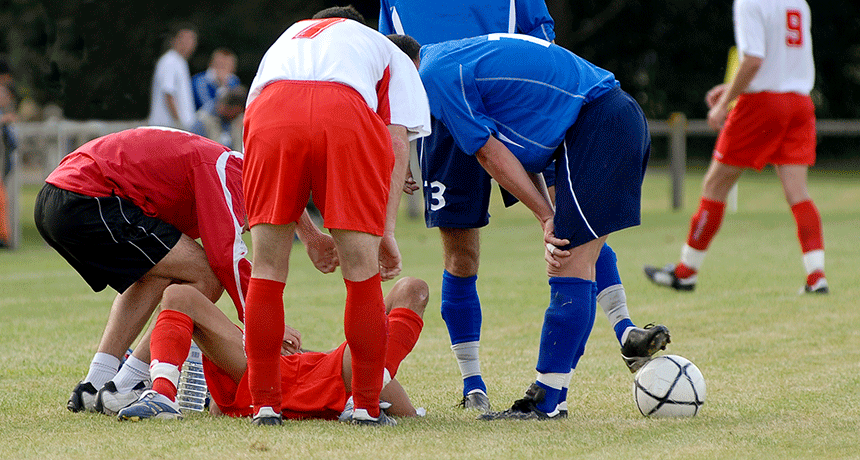Explainer: What is a concussion?
This severe type of head injury can damage a brain for weeks to years — perhaps a lifetime

A blow to the head can knock a player out of the game and might even cause a concussion.
saintho/iStockphoto
It may start with a car accident. Or a collision with another athlete on the basketball court or soccer field. Perhaps a cheerleader did a header off a human pyramid. In each case, the end result is the same — a whopping knock to the noggin. If the hit was particularly hard, doctors may diagnose the individual with a concussion.
Its symptoms can include forgetfulness, headache, dizziness, fuzzy vision and sensitivity to noise. Some people may vomit. Others undergo behavioral changes. They might become irritable or have trouble concentrating. Severe concussions can even knock someone unconscious. People in this sleeplike state are not aware of their surroundings and experiences.
Concussion occurs when the brain slams against the inside of the skull. The brain’s parts are not uniform in size and density. So when this organ collides with bone, some parts of the brain will move faster than others. That can cause parts of the tissue to twist and get squashed. These movements can damage delicate nerve cells.
Those nerve cells, or neurons, are what relay signals inside our brains. They connect with each other through long, slender structures called axons. It’s these axons that a head injury can damage.
Just like a wire carries electricity, an axon carries electrical signals. Those signals tell other parts of the brain, or specific parts of your body, what to do. Without neurons to communicate information from your eyes to your brain, you wouldn’t be able to understand — or even see — the words in this sentence.
All those neurons in the brain form the control center for the body. That’s why the body has a skull: to protect the brain.
The skull forms a solid barrier between that control center and anything that might harm it. A cushion of fluid inside the skull surrounds the brain, further protecting it. This fluid keeps the brain from banging into the skull during normal activity. But extreme head movements can be too much for that cushion to handle. When the head snaps forward, back or to the side, the skull stops moving. The brain, however, may keep going — and smack hard against the bone.
When an axon is stretched or twisted, the cells to which it is a part may die. That’s why symptoms of concussion may last for weeks to months. More worrisome: Some changes may persist for years, emerging data show. These may escape the notice of patients and their doctors. For instance, the brain may seem to perform just fine, yet have to work unduly hard just to manage simple tasks. Such subtle changes may never go away.
Especially troubling is that repeated concussions in professional athletes — especially in boxers and football players — have been linked with permanent memory problems, even dementia. Many of those changes have been associated with a type of progressive brain disease known as CTE. That’s short for chronic traumatic encephalopathy (En-SEFF-uh-LOP-uh-thee).
A 2017 study of the brains of 202 former U.S. football players, all now deceased, showed 177 of them had developed CTE. The same condition also showed up in the brains of some younger athletes, including three of 14 high school football players and 48 of 53 college players.
Clearly, concussion is nothing to be ignored. Most experts now recommend weeks or months of recovery before a concussed athlete resumes activities that may pose a risk of being reinjured.
Centers for Disease Control and Prevention (CDC)/YouTube







